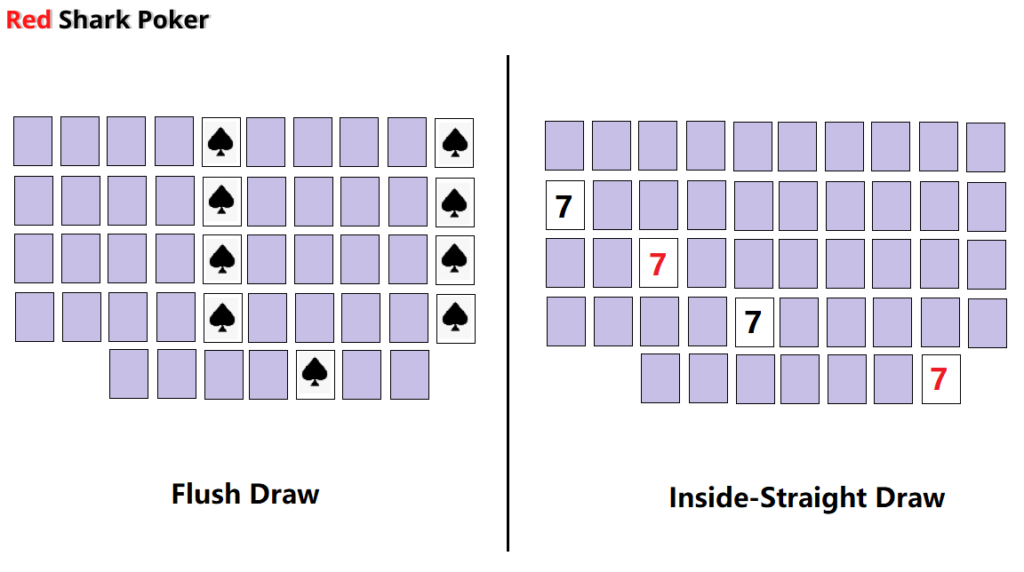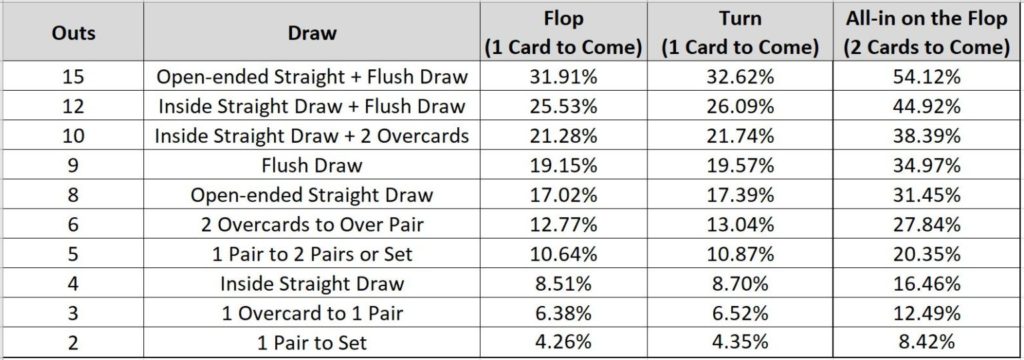

My Hand: 8♠ 9♠
Flop: K♠ T♠ 2♣
Oh boy! I have a flush draw on the Flop! I just need 1 spade. I check.
Opponent bets 3/4 pot.
I can still win a big pot on the turn. I call.
Turn: K♠ T♠ 2♣ 5♥
Oh! I missed it. Let’s just check.
Opponent bets full pot.
Oh, man! Why are you betting so big! I can still win big. Come on, 1 spade please!
I call.
River: K♠ Q♠ 2♣ 5♥ 10♦
Oh No! I missed my flush draw. I will bluff and steal the pot. ALL IN!
Opponent calls and shows K♣ 10♥.
Arghh! I am never playing poker again!
Do you go through the same horror while chasing draws in poker? If you do, you seriously need to upgrade your poker strategies. Let us first see how likely you are going to catch your outs with the concept of card odds.
What are Card Odds?
Card Odds is the ratio between the cards you don’t want in the deck and the cards that you do want in the deck. In other words, it is the ratio of unwanted cards and cards we want (outs).
Card Odds = Cards we don’t need : Cards we need
Let us calculate the card odds of the two popular draws – Flush Draw and Inside-Straight Draw.
Flush Draw
Your Hand: 6♠ 7♠
Flop: A♠ Q♥ 2♠
You have a flush draw with 9 outs. Let’s calculate the card odds now.
- A deck has 52 cards.
- We know 5 cards out of those 52 cards – Our 2 Hole Cards and 3 cards on the Flop.
- 52 – 5 = 47. There are 47 cards in the deck that we don’t know.
- There are 9 outs that will help us to make the flush. We need those 9 cards (outs).
- 47 – 9 = 38. We don’t need those 38 cards.
- Card Odds = Cards we don’t need : Cards we need
- Card Odds = 38:9
- 38:9 can be simplified as 4.2:1 or roughly 4:1
The card odds tell us that the odds of hitting a spade on the next street is 4:1. Of course, any of the spade-suited cards from the unknown 47 cards could have been dealt to other players. However, for the sake of simplicity, you can assume that for every 4 times, you won’t catch a spade, 1 time you will.
Inside Straight Draw
Hand: 5♠ 6♦
Flop: A♠ 8♥ 9♣
You have an inside straight draw with 4 outs. Let’s calculate the card odds now.
- A deck has 52 cards.
- We know 5 cards out of those 52 cards – Our 2 Hole Cards and 3 cards on the Flop.
- 52 – 5 = 47. There are 47 cards in the deck that we don’t know.
- There are 4 outs that will help us to make the flush. We need those 4 cards (outs).
- 47 – 4 = 43. We don’t need those 43 cards.
- Card Odds = Cards we don’t need : Cards we need
- Card Odds = 43:4
- 43:4 can be simplified as 10.75:1 or roughly 11:1
The card odds tell us that the odds of hitting a seven on the next street is 11:1. Of course, any of the sevens from the unknown 47 cards could have been dealt to other players. However, for the sake of simplicity, you can assume that for every 11 times, you won’t catch a seven, 1 time you will.
A Hypothetical Comparison of Outs
Let us assume that all of the outs of both flush and inside-straight draws are distributed evenly in the deck. With these ideal conditions, the outs in the deck of unknown 47 cards would look something like this.

Note: The real distribution would be random with a probability that other players might hold any of the outs in their hands. This hypothetical comparison shows how likely you can catch your out on the next street if all the outs are evenly distributed. The higher the number of outs, the higher are your chances of completing your draws.
When Should You Chase Draws?
When you have an unmade drawing hand, you need to consider two important aspects while chasing draws in poker – Pot Odds and Equity.
We hope you know the meaning of pot odds and equity. If you don’t, stop playing right now and learn these essential concepts first.
Learn Pot Odds: Pot Odds in Poker Explained
Learn Equity: Equity in Poker Explained
You must follow this golden rule while chasing draws in poker:
Equity Should be Greater than Pot Odds
When you are facing a bet with an unmade drawing hand, you must check whether your equity is greater than the pot odds. You should call only when your equity is greater than the pot odds.
Draws on the Flop
Now let’s look at two drawing hands on the Flop where your opponent bets the same amount. You need to decide whether to chase your draws or not.
Hand #1: 6♠ 7♠
Flop: A♠ Q♥ 2♠
Opponent Bets $50 into a $100 pot.
Pot Odds = 25%
You are quite sure that your opponent has an ace. However, you have a flush draw with 9 outs. If you use the Rule of 4 and 2, you have 36% equity (9 X 4).
36% (Equity) > 25% (Pot Odds)
As your equity is greater than the pot odds, you can choose to chase your draws. This also gives you a positive expected value of +$22. This means that you will be winning more money than losing in the long run. Learn how to calculate Expected Value: What is Expected Value in Poker?
Let’s look at the second hand.
Hand #2: 5♠ 6♦
Flop: A♠ 8♥ 9♣
Opponent Bets $50 into a $100 pot.
Pot Odds = 25%
Again, you are quite sure that your opponent has an ace. However, you have an inside straight draw with 4 outs (7♦ 7♠ 7♥ 7♣). You have the same pot odds but a lesser number of outs. If you use the Rule of 4 and 2, you have 16% equity (4 X 4).
25% (Pot Odds) > 16% (Equity)
As the pot odds are greater than your equity, calling here won’t be profitable in the long run. If you calculate the expected value, you will have a negative EV of -$16. This means that you will be losing more money than winning in the long run. So, you should fold.
Draws on the Turn
Let us look at the previous examples with the Turn card.
Hand #1: 6♠ 7♠
Turn: A♠ Q♥ 2♠ 10♣
Opponent Bets $200 into a $200 pot.
Pot Odds = 33%
You may have called on the Flop with correct pot odds, but now you are facing incorrect pot odds to chase your draws in poker. If you use the Rule of 4 and 2, you have 18% equity (9 X 2) with higher pot odds.
33% (Pot Odds) > 18% (Equity)
You still have 9 outs, but calling here won’t be profitable in the long run. You have a negative expected value of -$92. So, you will be losing more than winning in the long run if you call here.
Let’s look at the second hand.
Hand #2: 5♠ 6♦
Turn: A♠ 8♥ 9♣
Opponent Bets $150 into a $200 pot.
Pot Odds = 30%
If you use the Rule of 4 and 2, you have only 8% equity (4 X 2). You have incorrect pot odds to continue here.
30% (Pot Odds) > 8% (Equity)
As the pot odds are greater than your equity, calling here won’t be profitable in the long run. You have a negative expected value of -$110. Calling here would close to gambling as you will be risking a lot of money with the hope of catching one of the four outs on the river. If you call here, you will make a mathematically wrong decision. So, you should fold.
Don’t Bluff on the River with Missed Draws
You need to tell a consistent story for executing a successful bluff. If you call or check on the Flop and Turn on a drawing board, it becomes very obvious that you are chasing draws in poker. If you miss your draw on the river, don’t bet or raise to suggest that you have a strong hand. Your story doesn’t make sense. Your opponent can easily guess that you are bluffing and would call or raise you.
Equity Chart for Chasing Draws in Poker
The rule of 4 and 2 is a popular method for calculating equity on the fly. You can get a close estimate of your hand equity by multiplying the number of outs by 4 or 2. However, there are more accurate numbers that you can refer to by following the equity chart below. This chart shows less equity than the ones you get using the Rule of 4 and 2. Therefore, it is advised to chase your draws in poker cautiously.

Note: The last column All-in on the Flop (2 Cards to Come) is in a situation when you or your opponent go all-in on the Flop. In an all-in situation, you don’t have to call bets on the turn or river. So, you will see 2 cards till the river. Seeing 2 cards instead of 1 improves your odds.
Don’t Make Your Draws Too Obvious
When you complete your draws and bet to extract value, it becomes too obvious that you have completed your draw. For example, when the third spade hits on the river, your opponent will most likely know that you have completed your flush draw. If you bet, your opponent will probably fold. In other words, you won’t be duly rewarded for the risks you have taken to complete your draw.
This is why you should consider implied odds before chasing draws in poker. Implied odds give you an estimate of how much money you are likely to win if you complete your draw. If you think that implied odds are not good enough, it is not worth chasing draws as the reward is not lucrative enough for the risks you have taken. If you don’t know what implied odds are, click here: Implied Odds in Poker Explained.
Instead, Go for Semi-Bluffing!
Semi-bluffing is a tricky way of winning the pot right away without having to wait to complete your draws. However, there are lots of factors to consider before semi-bluffing in poker. Check out the complete guide on semi-bluffing: How to Semi-bluff in Poker?
It is easier to semi-bluff when you are in position. If you sense any weakness in your opponent, you can opt to semi-bluff and steal the pot. If you are out of position, you can choose to check-raise and steal the pot in a very cunning way. Let’s look at an example to understand how to semi-bluff with a check-raise.
Your Hand: A♦ 9♦
Flop: Q♠ 5♦ 2♦
You have a flush draw and have to act first. You check to see if your opponent bets.
1. If your opponent checks, you get to see a free card.
2. If your opponent bets, you can check-raise here.
When you check-raise here, you have disguised the strength of your hand. Your raise would represent a pair of queens. If your opponent folds, you win the pot right away. However, if your opponent calls and you complete your draw on the next street, your opponent will not likely believe that you have completed your flush. Your bet will seem like bluffs, and you can start extracting value.
Pro Tip: It is always better to have more outs while semi-bluffing. If bluffing doesn’t work, any of the outs can save you if they hit on the later streets.
Bottom Line
Chasing draws with an unmade hand is close to gambling. Your probability of winning depends completely on chance. Even if you have an open-ended straight flush draw with 15 outs, it doesn’t guarantee any victory. So, it is quite important to analyse how much you are willing to risk on an outcome that is completely based on chance. This is why you should consider pot odds and equity before chasing draws in poker. Or you can choose to play tricky by semi-bluffing without making your draws obvious and steal the pot.
Don’t gamble and chase draws to death! Be a smart player and chase draws logically to win pots!









